This tour will take you right to the heart of Bhutan, Bumthang (the central region). The trip will cover seven captivating destinations starting at Paro where you will hike to the most iconic attraction of Bhutan, the Tiger nest monastery. One of the highlights of this trip is the 30 minutes Mountain flight from Paro to Bumthang which offers beautiful views of the extended Himalayan mountains of Bhutan. You will also have the opportunity to see the highest unclimbed peak in the world Mt Gangkar Puensum from the flight. It not only offers mountain flight experience it saves time if you are not keen on driving long distances. This one-way flight and one-way drive will give you opportunity to visit the spiritual hub of Bhutan, Bumthang. The journey back to Paro will take you through high mountain passes and inspiring landscapes that will leave you breathless, from the majestic high mountain passes to serene valleys.
Paro is one of the most beautiful valleys in Bhutan and it is also the only gateway to Bhutan by air. Its administrative center, Rinpung Dzong, is one of the most sacred Dzongs of Bhutan, and in this beautiful valley you can find some of the earliest temples in the Kingdom such as the 7th century temple Kyichu Lhakhang, and Taktshang, also referred to as the Tiger’s Nest, built in the 17th century. Below are some of the favorite sites.
Day 1: Arrival – Paro
Altitude in Paro: 2300 m / 7544 ft above sea level.
Paro sightseeing should always start with the visit to the National Museum housed in the Ta dzong (watch tower). The intriguing collection of artefacts serves as a great introduction to the rich culture and heritage of the Kingdom. The National Museum boasts a rich variety of exhibits collected from all over the country and belonging to different eras, some as early as 2000 B.C. A visit through the galleries shows the country’s transition from the later Stone Age to a modern Mahayana Buddhist kingdom.
From the museum we will drive down to visit the Paro Dzong and take in the amazing architecture of this 17th century monument, a premier example of Bhutan’s architecture. Paro Dzong was built in 17th century to defend Paro from the Tibetan invasion. This fine example of Bhutanese architecture now serves as a central monastic and administrative seat of the Paro district.
From the Dzong, a leisurely walk back into Paro town crosses the scenic Nyamai Zampa, a unique model of Bhutan’s traditional cantilever bridge.
Next, visit the auspicious Kyichu Monastery. The seventh century monastery is one of the oldest and most sacred temples in the Kingdom. The Tibetan King, Songsten Gampo ordered the establishment of monasteries in the Himalayan region to subdue evil spirits and to spread Buddhism. Of the 108 monasteries two were built in Bhutan namely the Kyichu Lhakhang and the Jampa Lhakhang in Bumthang.
After the visit we will drive up north to take a walk around the Drukgyel Dzong. The Dzong was built in 1649 to celebrate a decisive victory over Tibetan forces and to stop further invasions. Under the leadership of Zhabdrung, the Bhutanese fought twelve battles with the Tibetans in different parts of the country, whereof one took place in Drukgyel Dzong. In the later years, the Dzong became an administrative center under the Dzongpon (Lord of the Dzong) until gutted by a fire in 1951. Now it’s being rebuilt with financial help of Indian government.
Overnight in Paro.
Day 2: Paro.
Taktshang (Tiger’s Nest).
Time: 20-minute drive to the base from the town, 4-5 hour walk round trip.
Difficulty level – Moderate.
Tiger’s Nest or Taktshang Goempa is one of Bhutan’s most revered monuments. It literally hangs off the face of a cliff 900 meters (2952 feet) above the valley floor. The legend states that Guru Rinpoche flew into Paro on a mythical tigress and meditated in a cave. The Taktshang Goempa is built around the cave, which is opened to the public once a year. The 4-5 hours round trip hike offers spectacular views of the Goempa and the valley below.
Horses or mules can be arranged on request to help lighten the journey.
Taktshang (Tiger’s Nest) to Drukgyel Dzong Hike.
Time: 2 – 3 hours from the trail head off the Taktshang trail, or 3 – 4 hours from Taktshang to Drukgyel Dzong.
Difficulty level – moderate.
If you have not spent all your energy walking up to Tiger’s Nest, you can continue on a beautiful hike all the way to Drugyel Dzong. This route takes you up to Ugyen Tshemo, just above Taktshang, and then north along the mountain ridge before descending down towards Drukgyel Dzong. You will have beautiful views of Paro Valley, Paro Chhu as you make your way to Zamsa village. Your car can pick you up just below Drukgyel Dzong.
Towards evening we will stroll around Paro Town is a must for all visitors who come to this valley. The town dates back from 1985 and its lined up by souvenir shops and café. If you are in for a good cup of café, stop at Mountain Café Roastery. They serve the best coffee in Bhutan.
Overnight in Paro.
Day 3: Transfer to Bumthang.
Distance: 322 km
Flight time: 30 minutes domestic flight offers beautiful view of the Himalayas of Bhutan.
Altitude in Bumthang: 2800 m / 9186 ft above sea level.
Bumthang is the most eastern point of your pilgrimage through the Land of the Thunder Dragon. It is considered by the Bhutanese as the spiritual hub of the country. The four valleys of Bumthang Choekhor, Tang, Ura and Chhume offer numerous experiences whether you want to hike, bike, discover temples, or learn more about Bhutanese lifestyle and culture. We hope you will enjoy exploring the magical Bumthang Valley.
After landing, the exploration of the Bumthang valley begins with visit to the Jakar Dzong. The Dzong was founded by Ngagi Wangchuk as a small hermitage in 1549. It was expanded in 1646 to help consolidate the Zhabdrung’s expanding power into the eastern region. Scouting for a place for the dzong, a small white bird was seen perched on a hill, which was taken as an auspicious sign, and hence the name Jakar, meaning the “white bird”. The dzong is now the seat of district administration and monastic body of Bumthang valleys.
From the dzong we will take a short drive to stretch and hike into the pine woods following the Nature Trail all the way to a local Bhutanese farm house for lunch. There the food is not just traditional Bhutanese food but serves Bumthang specialties made from local products such as buckwheat. By the time, you arrive at their house, the lady of the house will have spent the entire morning preparing a range of local dishes, including a taste of their home-made local wine (ara).
From the farm house, we wil continue our hike to visit the auspicious Jampa Lhakhang. The monastery is believed to have been built in the year 659 by the Tibetan King Songtsen Gampo, on the same day as Kyichu Lhakhang in Paro, in order to subdue a Tibetan demoness. It was here that Guru Rinpoche conducted the first sermon on Tantric Buddhism for his host King Sindhu Raja, the local ruler and his family. The place where Guru Rinpoche sat during the sermon can still be seen.
Next, from the farm house we will hike to the Aman lodge. On the way, we will stop to visit Kurjey Lhakhang. The monastery is named after Guru Rimpoche left his body print in the cave where he meditated in 746 A.D. There are three temples; the oldest temple was built in 1652 on the rock face where Guru Rinpoche meditated. The body imprint of the great master can be seen distinctly in the rock cave enshrined in the temple. The second was built in 1900 by the first King when he was the Governor of Trongsa. The third temple was built in 1990 with the support of the Royal grandmother. A wall of 108 chortens surrounds the temple grounds and symbolizes Buddha’s victory over the evil spirits. The Cypress tree which is seen near the temple is believed to have grown from the Guru’s walking stick.
From this monastery, our car will pick us up and drive to visit the Tamshing monastery where we can still see the Oldest Fresco painting dating back to 15th Century It was built by Pema Lingpa in 1501 and it is the most important Nyingma monastery in the Kingdom. Being a skilled tantric master and an artist, Pema Lingpa sculpted the main statues and painted the frescoes, which can be seen even today, mostly in original state.
Overnight in Bumthang.
Day 4: Bumthang.
Choekhor Valley – Tang Valley (Bumthang Cultural Trek):
This hike, also known as Bumthang Cultural Trek, is usually done over two or three days. However, by cutting the route slightly shorter, it is possible to do the hike in one full day. Drive down the Choekhor Valley. The paved road ends just below Kurjey and an unpaved forest road continues along the river and past charming small farmhouses, Thangbi Goemba, and further into the valley until the road ends by a suspension bridge where the trail starts. The path turns left after crossing the river and continues through meadows and forests without any steep inclines or declines for about two hours. The path then turns right and starts climbing the 500 meters to the Phephe La Pass. From here, the hike is delightful and continues slowly downhill through a dwarf bamboo forest, fields and more meadows until reaching a rough road leading to the pickup point, Tangsibi.
Tang is the most remote of the Bumthang Valleys and due to poor soil quality, agricultural yields are scanty. However, the people of the valley raise sheep and the area turns bright pink in October when the Buckwheat is in bloom.
If time permits, we will visit Ogyen Chholing Palace was originally built in the 16th century, however several parts were rebuilt after an earthquake in 1897. The family who currently owns Ogyen Chholing turned it into a museum a few years back, and opened a charming guest house on the palace grounds. The exhibition is laid out on three levels starting at the upper one where you can circle the floor before you continue to the floor below. The exhibits offer a rare insight to Bhutanese culture, lifestyle, history and religion. After having a look at the many artefacts, the Kitchen will be ready with your lunch which can be enjoyed outside the palace overlooking Tang Valley, or inside the traditional cabin-like living room. If you are interested, the Kitchen will gladly demonstrate the preparation of the Bumthang specialties, khuley (traditional Bumthang buckwheat pancakes) and/or puta (buckwheat noodles). (This needs to be booked in advance).
Overnight in Bumthang.
Day 5: Transfer to Phobjikha valley.
Distance: 160 km
Driving time: 6 hrs drive.
Altitude in Phobjikha valley: 2900 m / 9514 ft above sea level.
Phobjikha Valley is one of the most stunning areas in the country. The wide flat valley without any trees after the hard climb through dense forest is an extremely rare experience in Bhutan. In contrast to some parts of Bhutan, where modern development is already very apparent, Phobjikha is a place with natural beauty, untouched scenery, local traditions and culture, and unconstrained peacefulness.
Today our pilgrimage takes us back towards west Bhutan following the only east west highway over Yotong la Pass into Trongsa valley. There briefly visit the Trongsa Museum housed in the Ta Dzong (watch tower). This watch tower on the hill above the Dzong has been converted in to a state of art museum in 2008.
Visit also the Trongsa Dzong. This commanding Dzong is perhaps the biggest and the most spectacular sited Dzong in Bhutan. The Dzong’s strategic location gave it great power over this part of the country. It is the ancestral home of Bhutan’s royal family. The first two hereditary kings ruled from this dzong.
After the visit, continue driving through the alpine forest of fir, juniper, hemlock and rhododendron. On the way briefly visit Chendebje Chorten. The chorten is at a lovely spot by the river side. Built in 19th century by a lama from Tibet to cover the remains of an evil spirit. Chendbji is considered as boundary between eastern and western Bhutan.
The journey continues over Pelela pass and winding into glacier valley of Phobjikha filled with dwarf bamboos. The valley is one of the most important wildlife preserve in the country, because of the large flock of black necked cranes that migrates from Tibet in the winter.
Overnight in Phobjikha.
Day 6: Phobjikha valley.
Longtey Hike:
Time: 40 minutes’ drive to the starting point, 4 hours walk back towards Gangtey Gompa.
Difficulty level -Moderate.
If you are looking for a picturesque hike through some of the most beautiful parts of Gangtey, this is the one. It is a 40 minutes’ drive from Phobjikha valley to the starting point in Longtey village on the East-West highway. Start by walking downwards following the path to the right of the road. The path will lead through bush bamboo towards a small cluster of village houses. There are beautifully colored rhododendron forests on both sides of the valley, and in the winter months, yaks graze in the area. Continue straight through the village upwards until you reach the start of mystifying old-growth rhododendron forest. For the next two hours or so, you might feel like you are in the settings of Lord of The Rings surrounded by tall old trees which appear to be living creatures around you. The last part through the forest is slightly steeper uphill until you reach the pass with impressive views of the Gangtey Goemba, the Shedra, the lodge and the rest of the valley. This is a nice place for lunch before you continue on the path as it slopes down the valley towards the idyllic Kumbu village. It is possible to get picked up from here, or you may continue down to the Gangtey Gompa.
And visit the famous 16th century Gangtey Goemba that overlooks the large green expanse of the valley. The monastery is surrounded by a large village inhabited mainly be the families of the Gomchens (lay monk) who take care of the monastery.
If you still want you can continue hiking the Gangtey Nature Trail, two hours of easy walking. This pleasurable walk will give you a nice feel of Phobjikha valley. From the small hilltop overlooking Gangtey Goemba, you head downhill through flower meadows to Semchubara village and from here through beautiful forests and into the open valley. The trail ends after the Khewa Lhakhang. The lone monastery in the valley.
On our way, back to the hotel we will stop to visit the Crane observation and education center. There we can watch the short documentary on the magnificent black necked crane.
Overnight at Phobjikha valley.
Day 7: Transfer to Punakha.
Distance: 87 km
Driving time: 3 hrs drive.
Altitude in Punakha: 1300 m / 4264 ft above sea level.
The sub-tropical valleys of Punakha and the surrounding mountain sides offer a large variety of attractive places to explore and discover monasteries and the most impressive Dzong in the country.
After two hours of descend we will arrive Wangdiphodrang province. There we will visit the Wangdiphodrang Dzong which was burnt down by fire in 2012. The original Dzong was built in the 17th century by Zhabdrung (the one who unified Bhutan).
After Picnic lunch by the riverside we will visit the stunning Punakha Dzong. The Dzong is considered one of the most important and also one of the most beautiful Dzongs in the Kingdom. It was built by Zhabdrung in 1637, and was the seat of the government every winter until Thimphu was established as the permanent capital in 1955. It is still the winter residence of the Central Monastic Body.
Next, we will travel up the valley north and cross the Mo Chhu to hike up and pay respect to the grand Khamsum Yuelley Namgyal Chorten, The Chorten is 30 meters (100 feet) tall and can be seen in the distance when driving or walking up from the footbridge towards the lodge. The three-leveled chorten took eight and a half years to build and was consecrated in 1999. Dedicated to the Fifth King, it was built to remove negative forces and to provide peace, stability, and harmony in an ever- changing world. It is therefore filled with every form of colorful protector imaginable.
Overnight in Punakha.
Day 8: Punakha.
Jungle Hike to Hokatsho – Bhutan’s Largest Lake
Time: Total 6 – 7 hours hike.
Note that due to dense vegetation, mud and leeches, this hike is not recommendable during summer. Difficulty level – Strenuous.
This beautiful untouched lake is hidden away in the middle of dense jungle vegetation. Those who venture on this journey are up for an exciting meeting with overwhelming beautiful nature up close.
The hike starts on a red mud path sloping uphill through small villages before reaching the 15th century temple Chorten Nyeabu (described above). From here, the path follows a man-made creek all the way to the lake. As you proceed upwards, the vegetation gets denser. The mesmerizing sounds created by the many interesting insects are impressively loud and sedative. When reaching the lake, a small path leads down to the water for some magnificent views of Hokatsho in its peaceful and untouched surroundings. Take a few minutes to take in the beauty of the setting before continuing down again on an alternative path which is not as steep. (Should you wish to walk around the lake, this takes about two hours.) When reaching the village nearby Chorten Nyeabu, we can arrange for you to have your picnic lunch in one of the charming farmhouses scattered on the hillside overlooking the valley. Here you can enjoy the gorgeous views from the family room whilst sipping some ngaja with the locals, before commencing on the last hour down to the pickup point.
If time permits, we will drive at a hill top to visit a Sangchhen Dorji Lhendrup Lhakhang (Nunnery) built by maternal grandfather of the king. The Nunnery also serves as higher learning institute and meditation center for Nuns. It is perched on a ridge overlooking the Punakha and Wangdi vally.
Overnight in Punakha.
Day 9: Transfer to Thimphu.
Distance: 71km
Driving time: 3 hrs drive.
Altitude in Thimphu: 2400 m / 7872 ft above sea level.
Today the journey brings you to the booming metropolis of Thimphu. Situated at an altitude of 2,300 m, it is home to 140,000 Bhutanese. Since it was established as the country’s capital in 1961, Thimphu has gone through drastic changes and has settled into a well-balanced mix of old and new, traditional and modern. It is the only world capital without traffic lights.
At Dochula mountain pass (3050 meters above sea level) if weather permits, we will have spectacular view of the extended eastern Himalayas in Bhutan.
After the short stretch at the pass we will take the Dochula – Lungchutse – Tashigang Goemba Hike.
Time: 4-5 hours
Difficulty level – Moderate.
One of the most rejuvenating and picturesque hikes during your kora journey is the Dochula to Lungchutse and Trashigang Goemba, not only the hike itself is beautiful, but the 360° view from Lungchutse temple is one of the best you will get of the Himalayan mountain range.
You will start your hike from the large chorten in the middle of Dochula, the pass between Thimphu and Punakha at 10,300 ft / 3,140 m above sea level. From here the trail slowly climbs a ridge through a forest of hemlock, birch and rhododendrons until reaching an open meadow. Again, you will enter into forest of moss-covered rhododendrons, gigantic hemlocks, junipers, and bamboo undergrowth. A small trail leads you the last 160 ft / 50 meters past a row of fluttering prayer flags up to Lungchutse temple.
On clear days, the view from the temple is fantastic! You will have a 360° view of the Himalayas including views of Jumolhari (24,000 ft / 7,314 m), Masang Gang in the region of Laya (23,500 ft / 7,158 m), Zongophu Gang – a Table Mountain that dominates the isolated region of Lunana (23,160 ft / 7,060 m) and Gangkhar Puensum, the highest peak in Bhutan and the highest unclimbed peak in the world (24,600 ft / 7,497 m). You can also see Gasa Dzong, as a tiny white speck in a sea of green almost 31 miles / 50 kilometres to the north.
A trail to the left just 490 ft / 150 m below Lungchutse, leads to Trashigang village and temple. It slowly descends through spruce, rhododendron, hemlock and juniper forest. The village’s many dogs will warn the villagers about your arrival as you walk through the settlement down to the temple. It is nice to have lunch around the chorten in the temple’s courtyard while watching the monks in their daily endeavors.
The trail leading down from the front of the temple zigzags quite steeply down the side of the mountain until reaching a farm road which takes you up to the main road. Unless you have had enough hiking for one day, you might also want to visit Hongtsho village temple on the hill side to the right on the opposite side of the road. This involves a 30 – 60-minute short hike up through the little village and back down again the same way.
Trashigang Goemba was built in 1786 by the 12th Je Khenpo. It is an important mediation centre, and houses statues of several Je Khenpos who meditated here.
Overnight in Thimphu.
Day 10: Thimphu.
The capital offers much more than just shopping. Below we have listed a variety of places of interest to visit and experience in this exuberant city.
Today morning being the last day of your trip top Bhutan we will avoid long hike instead we will focus on visiting the cultural sights and end with a short beautiful stretch with the view of the capital from a mountain top.
After breakfast we will circumambulating sacred National Memorial Chorten. This is a Tibetan-style chorten built in 1974 in memory of the late King Jigme Dorji Wangchuk who passed away in 1972. It is one of the most visible religious structures in town and for many people it is the focus of daily worship. Remember to walk around the Chorten at least once to gain merit and good luck.
Next, we will drive up a ridge to visit the Biggest Buddha Statue at Kunesel Phodrang in Thimphu. This statue of Buddha measures 52 meters. It is one of the largest statues in the world. The statue is made of bronze and is gilded in gold. There are many smaller Buddha statues placed inside.
We will also browse the striking collection of intricate textiles at the National Textile museum. The Museum introduces you to the living national art of weaving. The exhibition displays the major weaving techniques and styles of local dress and textile made by the Bhutanese women and men.
We will drive to the National Post Office for stamps. Bhutan is famous for producing unique and innovative stamps. After selling peculiar ‘CD-stamps’ Bhutan’s Post office now offers personalized stamps; we invite you to surprise your family and friends with your custom-made stamp made with one of your favorite holiday photographs!
Next, we will take in more of kingdom’s rich culture at the Folk Heritage Museum. The museum is a restored three story traditional rammed mud and timber house inaugurated as a museum by Her Majesty the Queen Ashi Dorji Wangmo Wangchuk in 2001. It showcases the traditional artifacts used now and, in the past, which helps connect people to the Bhutanese rural life.
Typical Bhutanese Lunch at the Museum restaurant.
Next, we will stretch by hiking to the ancient Wangditse Goemba. It is an easy hike thru pine forest and with good overview of King Jigme’s palace. (2 hrs. hike) Wangditse Goemba was founded in 1750 by the attendants of Bhutan’s 8th desi, Yeshey Rabgye. It was renovated in 2002 after it suffered serious damage in a windstorm in 1995. The monastery is further undergoing major renovation after it was destroyed by the earthquake in 2011.
On our way back, we will stop to visit the Mini Zoo. The zoo used to exhibit various indigenous wild animals, which were later released back into the wild by order of the 4th King who declared that such a facility was not in keeping with the Bhutan’s environmental and religious convictions. The zoo now only features the Takin, which is the national animal of Bhutan. The Takins were originally released with the rest of the animals, but had become so familiar with people that they were found wandering around Thimphu looking for food. The only solution was to put them back into captivity.
In the evening you can stroll in the town, visit the Local Craft market just above the Textile museum and visit local handicraft shops.
Overnight in Thimphu.
Day 11: Transfer to Paro for International departure.

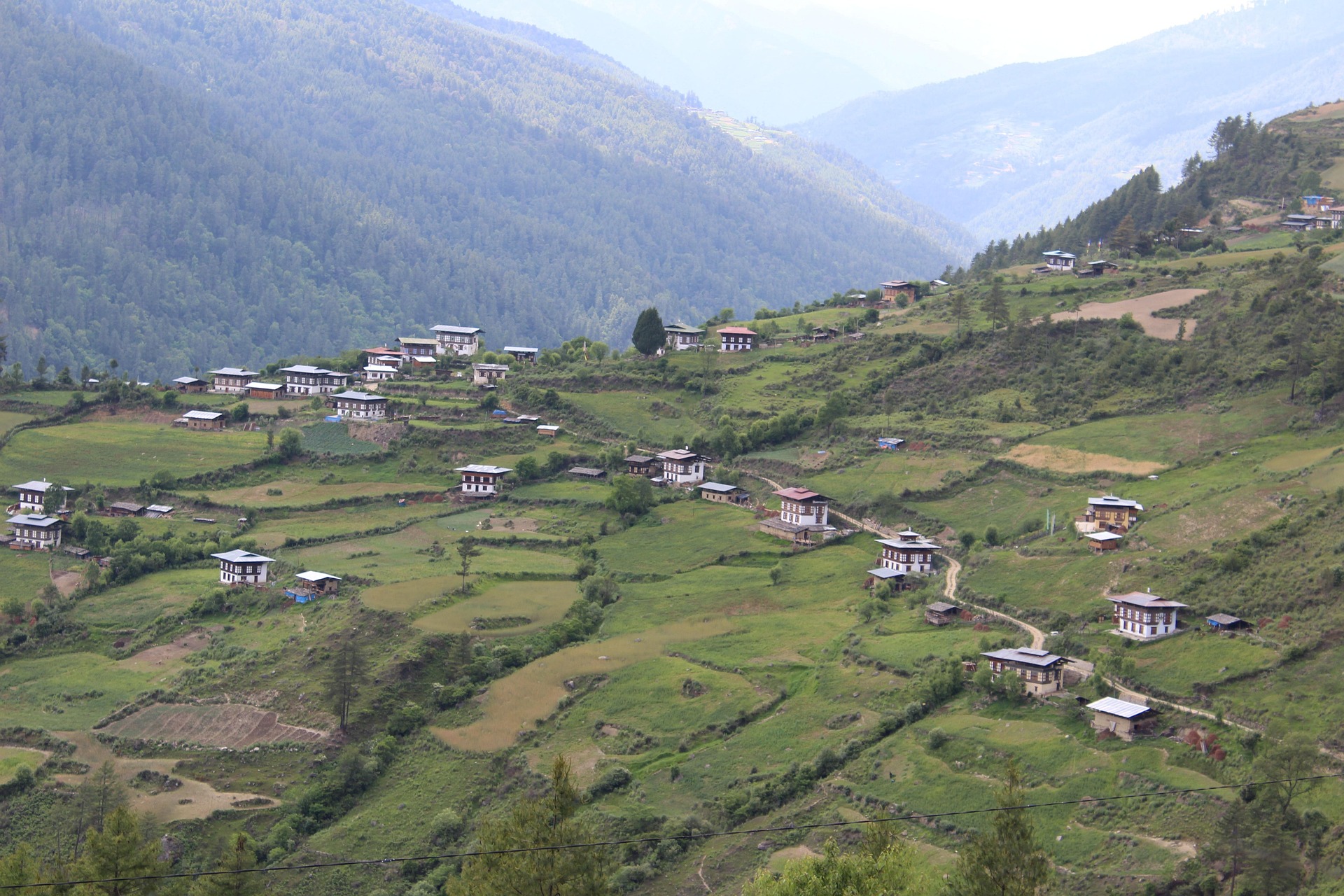
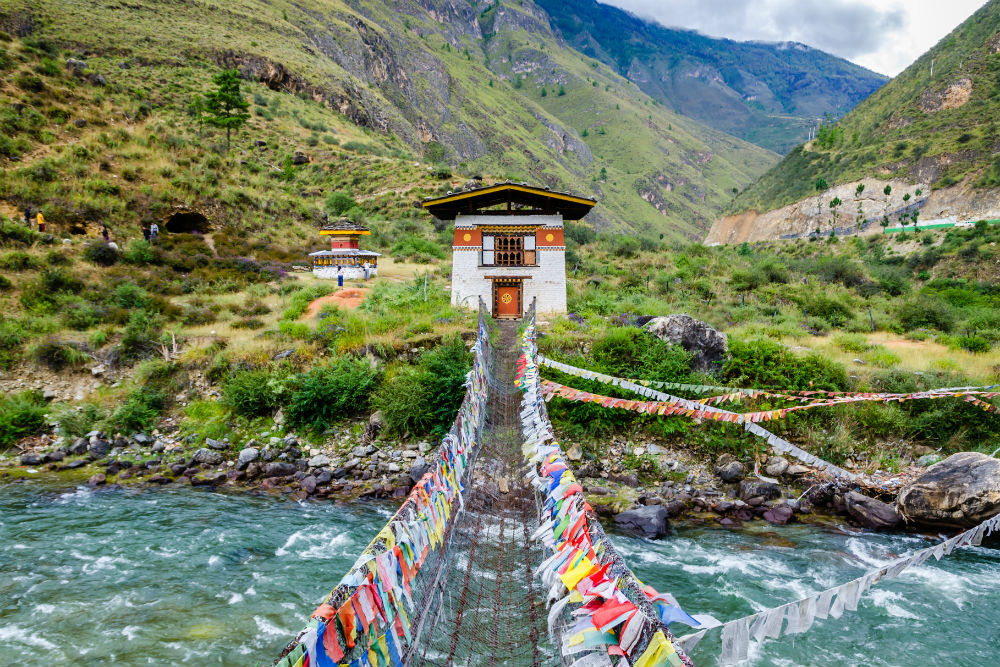
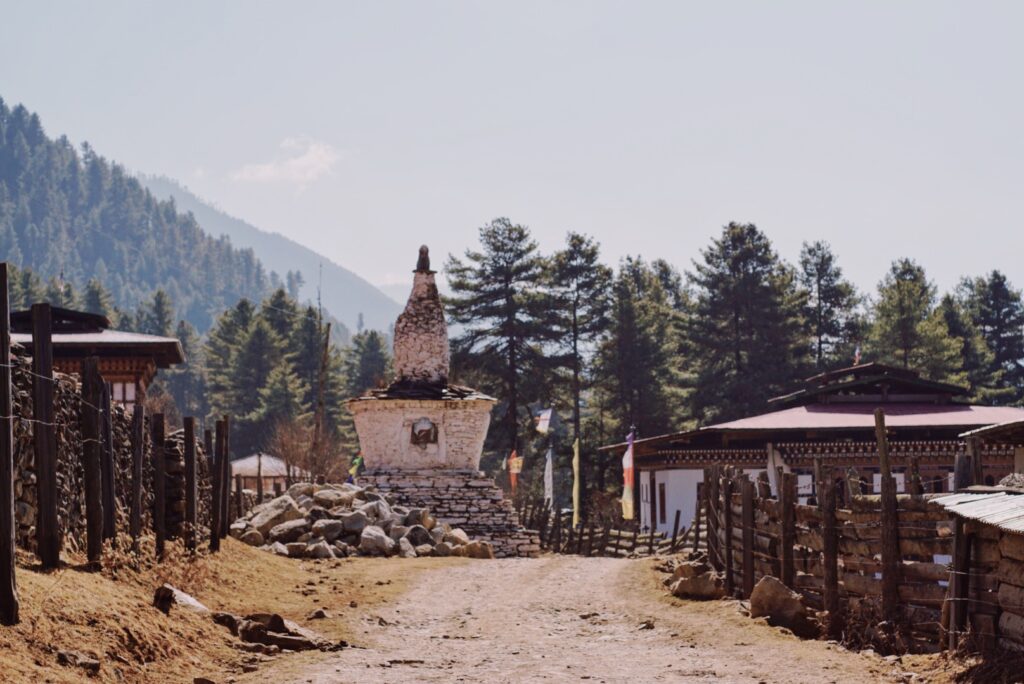
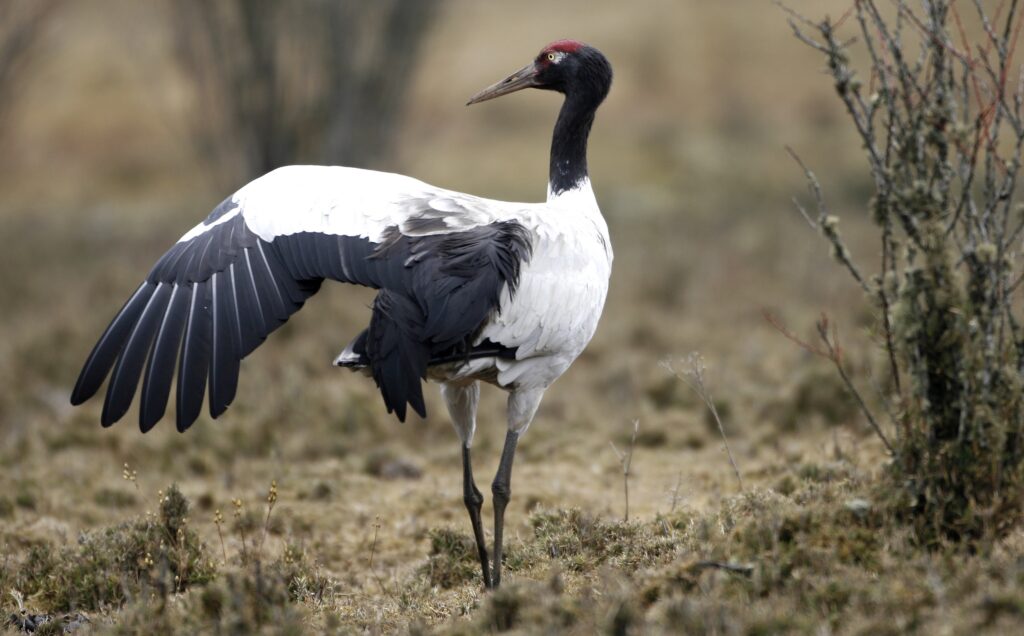
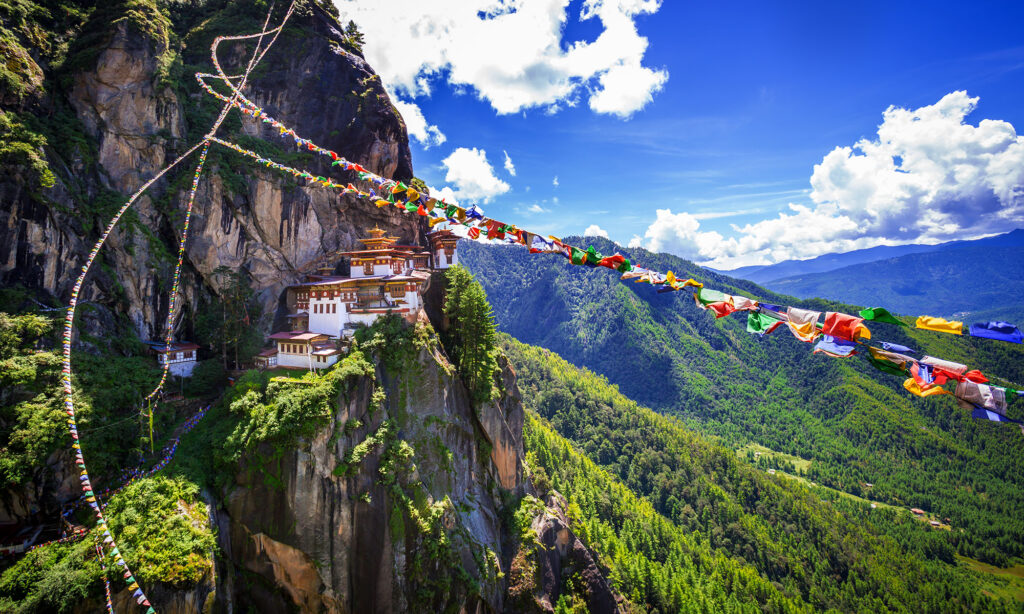
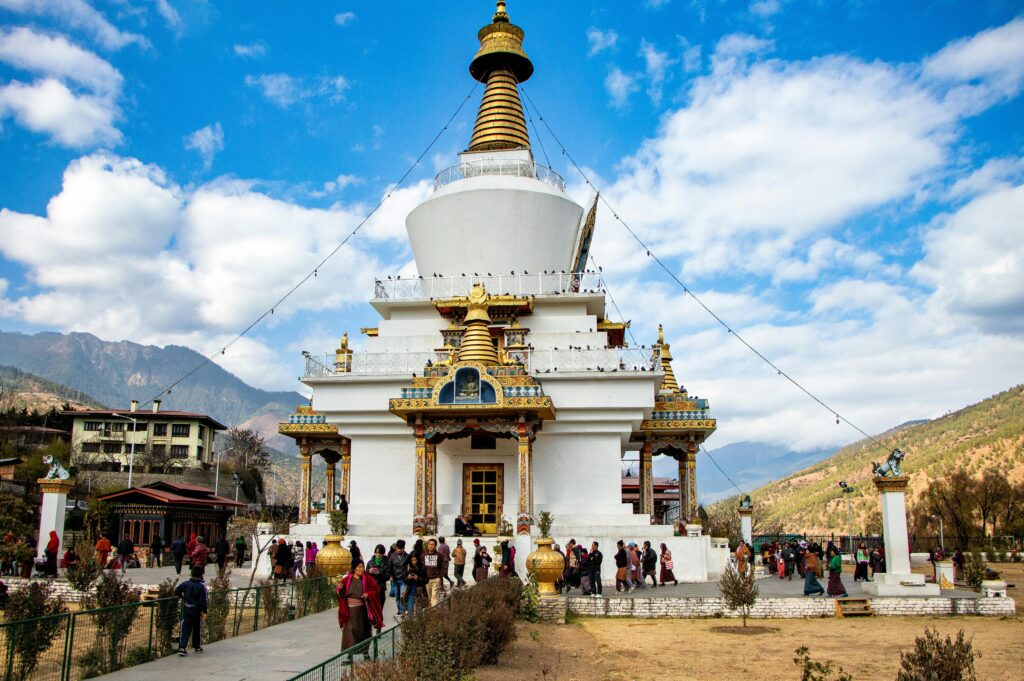
Leave a Reply
Your email is safe with us.